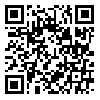دوره 5، شماره 2 - ( 6-1397 )
جلد 5 شماره 2 صفحات 220-205 |
برگشت به فهرست نسخه ها
Download citation:
BibTeX | RIS | EndNote | Medlars | ProCite | Reference Manager | RefWorks
Send citation to:



BibTeX | RIS | EndNote | Medlars | ProCite | Reference Manager | RefWorks
Send citation to:
Eskandari F. The modeling of body's immune system using Bayesian Networks. NBR 2018; 5 (2) :205-220
URL: http://nbr.khu.ac.ir/article-1-2963-fa.html
URL: http://nbr.khu.ac.ir/article-1-2963-fa.html
اسکندری فرزاد. مدل سازی سيستم ايمنی بدن با استفاده از شبکه های بيزی . یافتههای نوین در علوم زیستی. 1397; 5 (2) :205-220
دانشگاه علامه طباطبایی
چکیده: (7590 مشاهده)
در این مقاله براساس الگوی شبکه های بيزی در ساختار مارکوفی و درختی، که يکی از الگوریتمهای معروف در يادگيری ماشين است، به مطالعۀ عفونت ادراری افراد، که يکی از علايم شايع در ضعف سیستم ایمنی بدن است، پرداخته شده است. در این مقاله یک نمونه در مقیاس بزرگ برای ارزیابی عملکرد الگوریتم شبکه های بیزی انجام شده است. در اين مطالعه 4052 نمونه از بانك اطلاعاتي مربوط به معاونت درمان دانشگاه علوم پزشكي قزوين- مركز بهداشت و درمان شهرستان تاكستان استخراج شد که هم آزمايش تحليل ادرار و هم آزمايش كشت ادرار داشتند. با توجه به اهداف مطالعه و با استفاده از نظر متخصص آزمايشگاه و متخصص ارولوژي 15 متغير انتخاب شد. متغير نوع عفونت ادراری به عنوان پاسخ و 14 متغير ورودی در مدل شبکۀ بيزی با الگوريتم های مختلف تحت بررسی قرار گرفتند. نتایج نشان میدهد روش شبکۀ بيزی با ساختار درختی و انتخاب گام به گام متغيرها تقريباً بدون خطا برای 7/ 99 درصد از دادههای آموزشی، (75 درصد از کل دادهها)، و 8/99 درصد داده های آزمايشی (25درصد از کل داده ها) دارای تشخیص درست است. براساس الگوی شبکه های بیزی، متغیرهای کمکی تأثیرگذار بر عفونت ادراری، افزایش باکتریها و کاهش گلبول های سفید خون در گروه های سنی مختلف به دست آمده است. نتایج این مطالعه در چارچوب یادگیری ماشین و سيستم های هوشمند، میتواند برای تشخیص سریع این بیماری و درمان افراد مشکوک به این بیماری در سطح جامعه بدون حضور فيزيکی استفاده شود
نوع مطالعه: مقاله پژوهشی |
موضوع مقاله:
علوم گیاهی
دریافت: 1396/7/1 | ویرایش نهایی: 1397/7/10 | پذیرش: 1396/7/1 | انتشار: 1396/7/1 | انتشار الکترونیک: 1396/7/1
دریافت: 1396/7/1 | ویرایش نهایی: 1397/7/10 | پذیرش: 1396/7/1 | انتشار: 1396/7/1 | انتشار الکترونیک: 1396/7/1
فهرست منابع
1. Get persistent links for your reference list or bibliography. Copy and paste the list, we’ll match with our metadata and return the links. Please register for citation matching, verify an email address, and agree to the terms. Members may also deposit reference lists here too.
2. eXtyles Logo
-------------
3. Castro, L.N. and Von Zuben, F.J. 2000. An evolutionary immune network for data clustering. – IEEE Brazilian Symposium on Artificial Neural Networks. pp 84-89.
4. Castro, L.N. and Timmis, J. 2002. Artificial immune systems; a new computational approach. – Springer-verlag. London, UK.
5. Castro L.N. and Von Zuben, F.J. 2000. The clonal selection algorithm with engineering applications. –GECCO 2000, Genetic and Evolutionary Computation Conference 36-37.
6. Dasguptaa, D., Yua, S. and Nino, F. 2011. Recent advances in artificial immune systems: models and applications. – App. Soft Comp. 11: 1574-1587. [DOI:10.1016/j.asoc.2010.08.024]
7. Engelbrecht, A.P. 2007. Computational intelligence an introduction, artificial immune systems. Second edition. Vol. 5, pp 413-448.
8. Graaff, A.J. and Engelbrecht, A.P. 2006. Optimised coverage of non-self with evolved lymphocytes in an artificial immune system. – Int. J. Comp. Intel. Res. 2: 127-150.
9. Heckerman, D.A. 1996. Tutorial on learning with Bayesian networks. Technical report. – MSR-TR. 95-96.
10. Hunt, J.E. and Cooke, D.E. 1996. Learning using an artificial immune system. – J. Net. Com. App. 19: 189-212. [DOI:10.1006/jnca.1996.0014]
11. Jerne, N.K. 1974. Towards a network theory of the immune system. – Ann. Immunol. 2: 373-389.
12. Kim, J. and Bentley, P.J. 1999. Negative selection and niching by an artificial immune system for network intrusion detection. – GECCO 1999, Genetic and Evolutionary Computation Conference, pp 149-158.
13. Kim, J. and Bentley, P.J. 2002. Immune memory in the dynamic clonal selection algorithm. – 1st International Conference on Artificial Immune Systems, pp 59-67.
14. Nasraoui, O., Dasgupta, D. and Gonzalez. 2002. The promise and challenges of artificial immune system based web usage mining. – Second International Conference on Data Mining. pp 29-39.
15. Pearl, J. 1990. Bayasian network, UCLA, CL.
16. Rasoulzadeh, M., Golmakani, N., Ebrahimzadeh, Zagmi, S. and Nasiri, S. 2017. Cranberry Effects on Prevention of Urinary Tract Infection. – J. St. Res. Comm. Sabzevar Univ. Med. Sci. 22: 16-22.
17. Sarafijanovic, S. and Le Boudec, J. 2004. An artificial immune system for misbehavior detection in mobile ad-hoc networks with virtual thymus. – 3st International Conference on Artificial Immune Systems, pp 342-356. [DOI:10.1007/978-3-540-30220-9_28]
18. Shuohao, L., Zhang, J. and Boliang, A. 2014. An incremental structure learning approach for Bayesian network. – The 26th Chinese Control and Decision Conference. DOI: 10.1109/CCDC.2014.6853036. [DOI:10.1109/CCDC.2014.6853036]
19. Twycross, J. 2007. Integrated innate and adaptive artificial immune systems applied to process anomaly detection. – Ph.D. thesis, School of Computer Science. University of Nottingham, UK.
| بازنشر اطلاعات | |
 |
این مقاله تحت شرایط مجوز کرییتیو کامنز Creative Commons Attribution-NonCommercial 4.0 International License قابل بازنشر است. |








